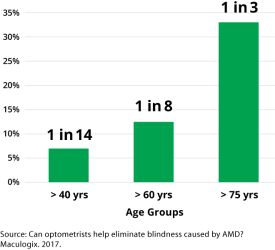What is age-related macular degeneration (ARMD)?

Age-related macular degeneration — also called macular degeneration, AMD or ARMD — is deterioration of the macula, which is the small central area of the retina of the eye that controls our sharpest vision, measured as our visual acuity.
The health of the macula determines our ability to read, recognise faces, drive, watch television, use a computer or phone, and perform any other visual task that requires us to see fine detail.
A meta-analysis of population studies of the prevalence of age-related macular degeneration published in medical journal The Lancet, found that 8.7 percent of the worldwide population has AMD, and the projected number of people with the disease in 2020 is around 196 million, increasing to 288 million in 2040.
Researchers have also estimated that approximately 5 percent of blindness globally is due to AMD.
Wet and dry forms of macular degeneration
Macular degeneration is classified as either dry AMD or wet AMD.
The dry form is more common than the wet form, with about 85 to 90 percent of AMD patients diagnosed with dry AMD. The less common wet AMD usually leads to more serious vision loss.
Here is a closer look at the two forms of AMD:
Dry AMD
Dry macular degeneration is an early stage of the disease. It appears to be caused by aging and thinning of macular tissues, depositing of pigment in the macula, or a combination of the two processes.
Dry AMD is diagnosed when yellowish spots known as drusen begin to accumulate in and around the macula. It is believed these spots are deposits or debris from deteriorating tissue.
Gradual central vision loss may occur with dry macular degeneration; but usually the visual impairment is not as severe as that caused by wet AMD. However, visual impairment from dry AMD can continue to progress year after year, eventually leading to significant vision loss.
Though there is not yet an effective medical treatment for dry AMD, nutritional studies have shown that dietary supplements containing antioxidant vitamins and lutein and zeaxanthin may reduce the risk of dry AMD progressing to the more severe wet stage of the disease.
Currently, it appears that if you are at risk of AMD, the best way to protect your eyes from developing early (dry) macular degeneration is to eat a healthy diet, exercise and wear sunglasses that protect your eyes from the sun's harmful UV rays and a certain band of blue light or what is called high-energy visible (HEV) radiation.
Wet AMD
In wet macular degeneration, abnormal blood vessels grow beneath the retina and leak blood and fluid. This leakage causes permanent damage to light-sensitive retinal cells (photoreceptors) in the macula and creates a central blind spot (scotoma) in the affected person’s visual field.
Choroidal neovasclarization (CNV), the underlying process causing wet AMD and abnormal blood vessel growth, is the body's misguided way of attempting to create a new network of blood vessels to supply more nutrients and oxygen to the eye's retina. Instead, the process creates scarring, leading to sometimes severe central vision loss.
Age-related macular degeneration symptoms and signs
Age-related macular degeneration usually produces a slow, painless loss of vision. In rare cases, however, vision loss can be sudden. Early signs of vision loss from AMD include shadowy areas in your central vision, or unusually fuzzy or distorted spots that affects only the central portion of your field of vision.

An Amsler grid consists of straight lines, with a reference dot in the center. Someone with macular degeneration may see some of the lines as wavy or blurred, with some dark areas at the center.
Viewing a chart of black lines arranged in a graph pattern (Amsler grid) is one way to tell if you are having these vision problems. See how an Amsler grid works by taking a macular degeneration test.
Optometrists and ophthalmologists often detect early signs of macular degeneration before symptoms occur. Usually this is accomplished through a retinal exam. When macular degeneration is suspected, a brief test using an Amsler grid that measures your central vision may be performed.
If your optometrist detects some defect in your central vision, such as distortion or blurriness, he or she may do special imaging tests or refer you to an ophthalmologist to examine the retinal blood vessels surrounding the macula.
What causes macular degeneration?
Though macular degeneration is associated with aging, research suggests there is also a genetic component to the disease. Researchers have noted a strong association between development of AMD and presence of a variant of a gene known as complement factor H (CFH). This gene deficiency is associated with almost half of all potentially blinding cases of macular degeneration.
Other investigators have found that variants of another gene, complement factor B, may be involved in development of AMD.
Specific variants of one or both of these genes, which play a role in the body's immune responses, have been found in 74 percent of AMD patients who were studied. Other complement factors may also be associated with an increased risk of macular degeneration.
Other research has shown that oxygen-deprived cells in the retina produce a type of protein called vascular endothelial growth factor (VEGF), which triggers the growth of new blood vessels in the retina.
The normal function of VEGF is to create new blood vessels during embryonic development, after an injury or to bypass blocked blood vessels but too much VEGF in the eye causes the development of unwanted blood vessels in the retina that easily break open and bleed, damaging the macula and surrounding retina.
Who is at risk of age-related macular degeneration?
Aging is a primary risk factor for AMD. Each decade of life after age 40 significantly increases one’s risk for the disease. This is one reason why having routine eye tests after age 40 is so important.
Other risk factors for age-related macular degeneration include:
· Heredity. As stated above, recent studies have found that specific variants of different genes are present in most people who have macular degeneration.
· Smoking. Smoking is a major risk factor for AMD. Research has shown that, in some populations, smoking was associated with about 25 percent of AMD cases that caused severe vision loss. Another study found that people who live with a smoker have twice the risk of developing AMD.
· Obesity. Researchers have found that people with dry AMD who were obese had more than double the risk of developing advanced macular degeneration, compared with people of normal body weight.
· Inactivity. People with dry AMD who perform vigorous activity at least three times weekly reduced their risk of developing advanced AMD, compared with people with dry AMD who were sedentary.
· High blood pressure. A European study found that high blood pressure may be associated with development of macular degeneration.
Also, certain medications — such as anti-psychotic drugs and medications used to treat malaria (chloroquine) — may increase your risk of AMD.
How macular degeneration is treated
Currently, there is no cure for age-related macular degeneration.
Treatments are available to slow the progression of wet AMD. The most popular of these involve the injection of medications called anti-VEGF agents into the eye. These agents reduce new blood vessel growth and oedema (swelling) in the retina.
Nutrition and macular degeneration
Research is ongoing to determine if dietary modifications can reduce a person's risk of macular degeneration and vision loss associated with the condition. And some of these studies are revealing positive associations between good nutrition and reduced risk of AMD.
For example, some studies have suggested a diet that includes plenty of salmon and foods high in omega-3 fatty acids may help prevent AMD or reduce the risk of its progression.
Other studies have shown that supplements containing lutein and zeaxanthin increase the density of pigments in the macula that are associated with protecting the eyes from AMD.
Testing and low vision devices for AMD
If you are at high risk of AMD or have been diagnosed with the disease, your optometrist may ask you to check your vision regularly with the Amsler grid card (described above).
Viewing the Amsler grid separately with each eye helps you monitor for possible vision loss. The Amsler grid is a very sensitive test and it may reveal central vision problems before your optometrist sees AMD-related damage to the macula in a routine eye test.
For those who have vision loss from macular degeneration, many low vision devices are available to help with mobility and specific visual tasks.
Page published on Monday, 16 March 2020







